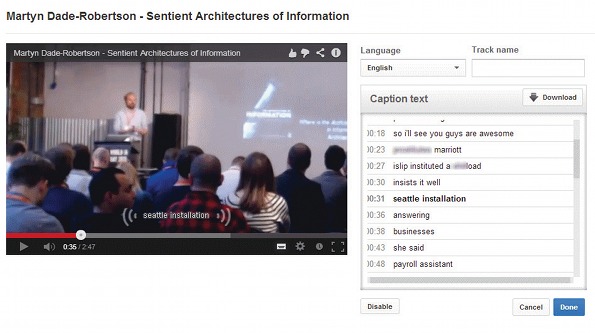Accessibility through video captions
Video captions are important for accessibility and search engines. Edit YouTube captions to prevent bloopers, says Alastair Campbell
I turned on captions for my account on YouTube a while ago when testing something, and forgot to turn them off. Then I realised that almost every YouTube video has captions, whether the owner knew about them or not. It also didn’t take long to realise that the quality of captions left a lot to be desired, as they often didn’t (sometimes to comic effect) match the audio.
In 2006, YouTube introduced the ability to upload captions for your video content, and then in 2009 Google brought captioning together with Automatic Speech Recognition (ASR). Together they became YouTube Auto-caps, and made it possible for captions to be automatically created for your video content.
Now activating the captions in the YouTube player causes Auto-caps to kick in and create captions on the fly as the video plays.
Quick recap: captions display the spoken dialogue and important sound effects from your video as on-screen text, synchronised with the original video soundtrack. They make it possible for deaf and hard of hearing people to understand video content with audio and, because they’re text-based captions, they also make your video content easier for search engines to index.
Despite the extraordinary difference Auto-caps have made to the availability of captioned content, from the outset it was clear that even Google’s ASR technology wasn’t perfect. Almost immediately examples of captioning bloopers began to appear, much to the amusement of consumers (if not to the video owners).
For example, in the video above here was no mention of “seattle installation” as shown in the caption. The actual words were “looking at the relationship between the design of virtual systems …”
To be fair, it’s not the clearest of audio recordings so it’s hardly surprising that the automatic captions don’t get it right. Even so, I did have to blur out some rude words added by the captioning.
The only thing worse than bad captions is no captions, so I think YouTube is right to enable this by default. It’s up to us to make sure the captions make sense, which can also help people find the content (correctly) in the first place through search engines, as text content can be indexed.

You can see from the example above that YouTube provides an interface for editing the captions, or you can download a time-stamped file to edit and upload.
Once logged in, go to your Video Manager and locate the video you want.
Use the down arrow (to the right of the Edit button) and select the Captions.
Update the language of your captions (it allows you to add captions in many languages).
Either edit the captions in place, or download the text file for editing.
It’s really simple to do, so please think of the people who cannot hear the audio and get editing those captions!
Get the Creative Bloq Newsletter
Daily design news, reviews, how-tos and more, as picked by the editors.

Thank you for reading 5 articles this month* Join now for unlimited access
Enjoy your first month for just £1 / $1 / €1
*Read 5 free articles per month without a subscription

Join now for unlimited access
Try first month for just £1 / $1 / €1

The Creative Bloq team is made up of a group of art and design enthusiasts, and has changed and evolved since Creative Bloq began back in 2012. The current website team consists of eight full-time members of staff: Editor Georgia Coggan, Deputy Editor Rosie Hilder, Ecommerce Editor Beren Neale, Senior News Editor Daniel Piper, Editor, Digital Art and 3D Ian Dean, Tech Reviews Editor Erlingur Einarsson, Ecommerce Writer Beth Nicholls and Staff Writer Natalie Fear, as well as a roster of freelancers from around the world. The ImagineFX magazine team also pitch in, ensuring that content from leading digital art publication ImagineFX is represented on Creative Bloq.
